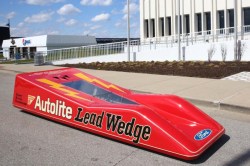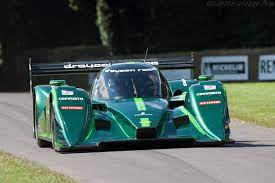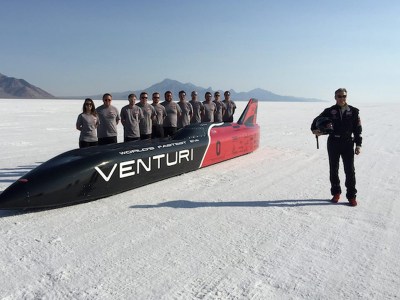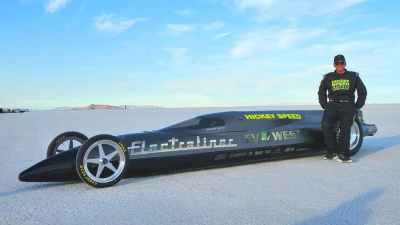Electric Land Speed Racing Can Be Lightning Fast

Land speed racing is a pursuit of ultimate speed above all else. Most cars typically run on huge, flat salt pans, and racers run flat out for miles in a straight line, attempting to push their machines to the limit. Like most motorsports, the history of land speed racing has traditionally been centred around internal combustion, but electric racers have long been out there chasing land speed records as well.
The Need For Speed
At the most famous land speed trials, such as Bonneville’s Speed Week, speed runs take place over miles and miles of open salt, with timing traps along the way to determine competitor’s speeds. These tracks are long enough that acceleration is of little concern, which is of great benefit to electric runners. Additionally, only one or two runs is required to set a record. This means that heavy batteries aren’t always needed, as the distance a competitor must travel is short, and even if the batteries are heavy, it doesn’t excessively affect top speed.
With an eye to that, land speed competitors in electric classes are typically classified into weight classes. This is due to the fact that bigger, heavier battery packs can deliver more current, and thus potentially have a performance advantage over lighter vehicles. Thus, typical classes run by most salt flats competitions involve the E1 class, which allows for vehicles under 1100 lbs, the E2 class, for vehicles up to 2200 lbs, and the E3 class, which is for anything 2200 lbs and above. The FIA also publish their own set of classes, again separated by weight, though to a much more granular degree.
Procedures for setting records vary depending on the venue and the record in question. Local records at salt venues like El Mirage can typically be broken with a single run faster than the standing record, while Bonneville Speed Week competitors must set a higher average speed across two runs on two consecutive days. FIA records differ again, and are perhaps the most stringent, requiring competitors to set a faster average across two runs in opposite directions, set within an hour of each other, to attempt to minimise the effect of wind on the result. Things can sometimes get confusing, as many FIA records, for example, are set at the Bonneville salt flats, but not actually in Speed Week competition or by Speed Week rules.

Unlike more traditional land speed racing classes, electric vehicles typically run in an “unlimited” body class, where anything goes. This is due to the fact that in the early days when rulesets were being figured out, there simply were no “production” electric cars to compete. Thus, the classes have by and large always been open to any and all body designs, with the vast majority of record breakers adopting rail-like streamliner chassis designs.
History
The stories of land speed racing attempts are weaved over many years, as projects coalesce to take on a highly specific record, best it, and move on. Records can stand for decades, before they’re unearthed by a new generation, who spawn a new build and push the record ever higher. Electric land speed records are no different, often standing for long periods of time before tumbling in the face of new teams with new technology.

The Autolite Lead Wedge, recently for sale by its owner, is a great example of an early entry to the world of electric land speed racing. In 1968, with Jerry Kugel tucked in under the fibreglass canopy, it set a record of 138.862 mph over a mile to claim the FIA record. It was built in part to promote the new line of Autolite lead-acid car batteries, 20 of which were used to propel it across the Bonneville salt flats.

Amazingly, in the FIA’s 500 kg to 1000 kg weight class for electric competitors, it’s only been beaten twice since. In FIA records maintained online, the record next fell in 1974, to a car by the name of Battery Box, powered by a General Electric forklift motor and around 30 lead acid batteries, depending on the run. In a two-way average, it bumped the record to 174.981 mph over a mile. The record was then to stand for another 39 years, beaten by Lord Drayson in the Drayson B12/69EV in 2013 at RAF Elvington. The modified former Le Mans car, equipped with modern lithium-ion cells and axial-flux motors, clinched the record with a FIA confirmed speed of 205.139 mph. At the absolute top end of performance, however, stands the Venturi Buckeye Bullet 3. Running in the heavier weight class for vehicles between 3500 kg and 4000 kg, it set a scorching speed of 341.264 mph over a mile, eclipsing top speeds set by vehicles in lower classes.

Records at salt racing events like Speed Week tend to attract more regular competition. Events run every year and don’t require competitors to arrange their own timing equipment, and records are verified by the volunteer associations that run the events themselves. They also have the benefit of allowing competitors plenty of time to prepare between runs – unlike the FIA’s one hour time restriction, which can be punishing for electric vehicles that need to swap or recharge batteries. The Southern California Timing Association maintains these records, with their classes and rulesets adhered to by salt racers the world over. Currently, the BYU Streamliner has held the E1 weight class record at 204.893 mph since 2014, while last year saw the EV West Electraliner take the E2 class record at 229.363 mph. Meanwhile, the heaviest E3 class has been held by the Buckeye Bullet since 2004 with a speed of 314.958 mph – the predecessor to the vehicle currently holding the FIA outright EV speed record. Unlike more modern entries, the original Buckeye Bullet set its record using nickel metal hydride batteries.
Conclusion
Like any land speed record attempt, success in the electric realm requires good engineering, careful planning, and here and there, a dose of luck. Poor conditions and equipment failures have scuppered many a land speed racer’s shot at glory, and it can and will happen again. If you decide you need to take a tilt at entering the history books, take a gander at our in-depth primer to the sport. And, most of all, good luck!
Post a Comment